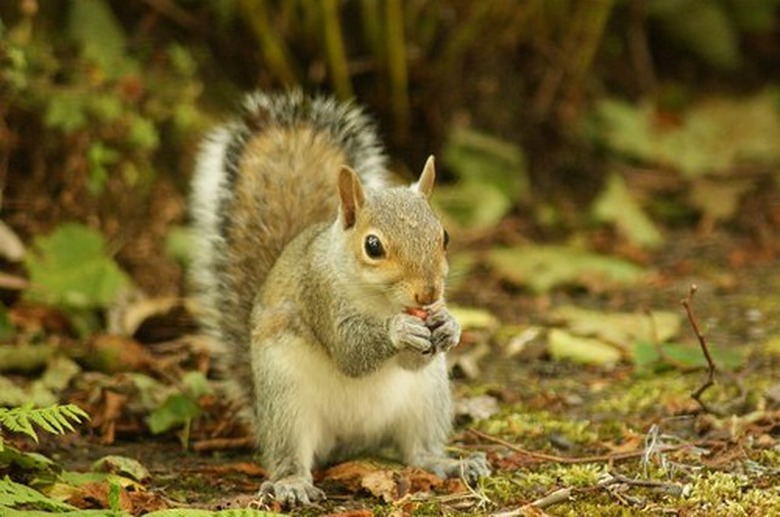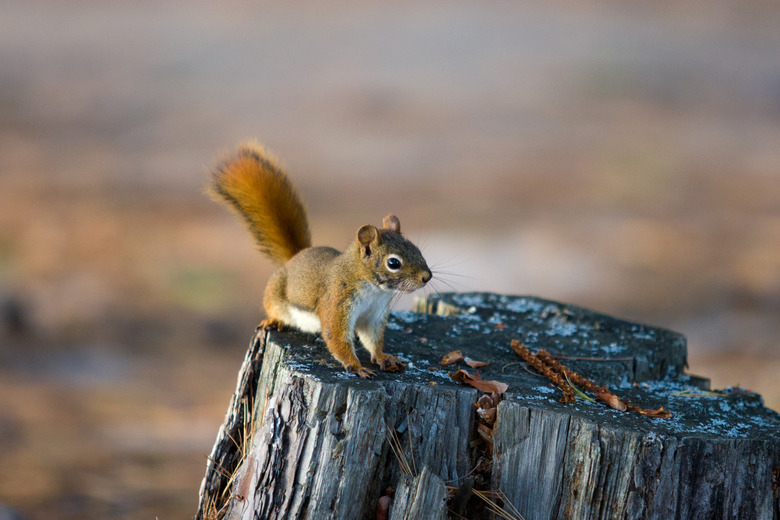Squirrel Life Cycles
About 25 percent of all squirrels don't make it past the first year of life. The death rate for squirrels stays high for its first two years of life due to predators, diseases and road accidents. A squirrel that makes it past its first two years can expect to live an average of four to five more years. Female squirrels give birth to an average of two to three squirrels per litter – with two litters per year – but can have up to nine squirrels in one litter. In the U.S., there are multiple squirrel species, but the most common include the eastern and western gray squirrels, red, black, fox and ground squirrels.
TL;DR (Too Long; Didn't Read)
The average life expectancy of a squirrel tops at between six to seven years old, with lucky squirrels living up to 12 years in the wild and up to 20 in captivity.
Squirrel Population in the U.S.
Squirrel Population in the U.S.
An acre of forested land can support from one to five squirrels, with an average of about two squirrels per acre. With over 818 million acres of forests and woodland across the United States, that represents a squirrel population of about 1 to 4 billion squirrels in the country. But only about 25 percent of gray squirrels survive their first year. Gray squirrel litters average two to three squirrels, but females can bear up to nine in one litter.
Life Cycle of a Squirrel
Life Cycle of a Squirrel
It takes about 40 to 44 days for the gestation period of female squirrels with one to nine babies born into the leafy den, which is usually a hollow in a tree. At birth, squirrel babies – neonates – are born hairless and blind, and it takes them between 28 to 35 days before they open their eyes. They begin to leave the nest at between 42 and 49 days, but the mother doesn't wean them until until they reach 56 to 70 days old, when they go out on their own. Squirrels born in the late summer may stay with the mother over the winter. Females and males mate in the spring or summer following their birth.
Disease, cataracts, parasites, tooth loss and other debilitating events impact the life expectancy of a squirrel so that as they age and slow down, their ability to survive decreases. Squirrel lifespan averages anywhere from six to 12 years in the wild, if they're lucky, and up to 20 years in captivity. The strong do survive, and adapt, especially in urban areas, where squirrels often use utility wires as a means of getting about. Squirrel predators include several animals: rattlesnakes, weasels, black snakes, skunks and foxes, but their biggest threat comes from above from hawks and owls.
Habits, Activity and Movement
Habits, Activity and Movement
Squirrels forage for food about four to six hours a day just after dawn and before dusk, with the remainder of the day spent lounging or sleeping. Squirrels don't hibernate, but do stay in their nests during heavy bouts of winter weather. On cloudy days, or during courtship, they may spend more hours up and about. Squirrels are as agile on the ground as they are among the tree canopies of the forest. They use their very sharp claws for grabbing ahold of bark and their long tails for breaking leaps and balance. Their bodies can twist and turn on a dime atop thin branches. When frightened, they freeze and flatten their tail and body against a tree trunk or branch, inching around the circumference of the tree or branch to avoid predators. Squirrels have even been known to swim across lakes.
Cite This Article
MLA
Brenner, Laurie. "Squirrel Life Cycles" sciencing.com, https://www.sciencing.com/squirrel-life-cycles-5542667/. 22 November 2019.
APA
Brenner, Laurie. (2019, November 22). Squirrel Life Cycles. sciencing.com. Retrieved from https://www.sciencing.com/squirrel-life-cycles-5542667/
Chicago
Brenner, Laurie. Squirrel Life Cycles last modified March 24, 2022. https://www.sciencing.com/squirrel-life-cycles-5542667/

